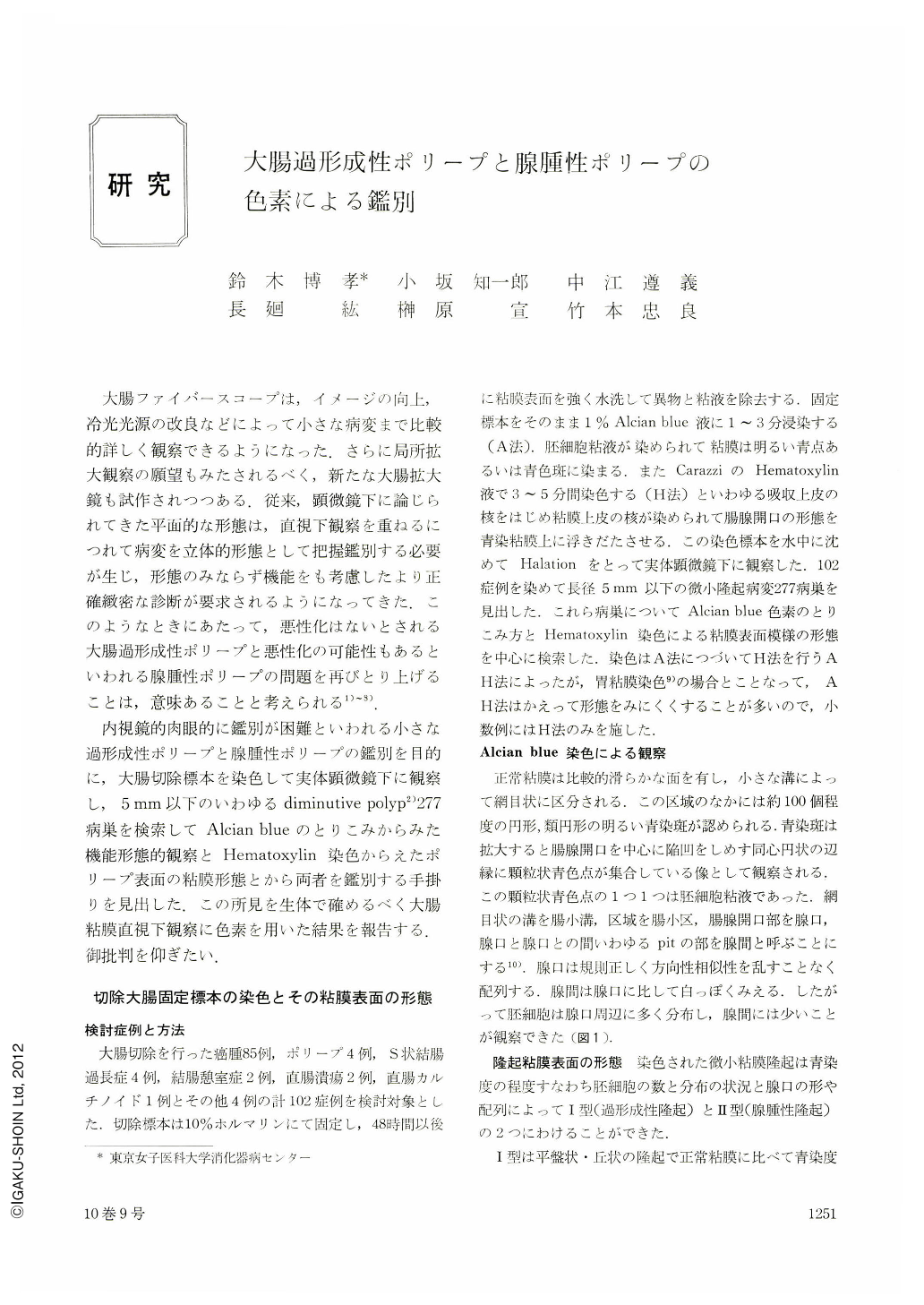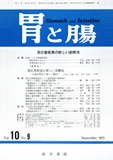Japanese
English
- 有料閲覧
- Abstract 文献概要
- 1ページ目 Look Inside
大腸ファイバースコープは,イメージの向上,冷光光源の改良などによって小さな病変まで比較的詳しく観察できるようになった.さらに局所拡大観察の願望もみたされるべく,新たな大腸拡大鏡も試作されつつある.従来,顕微鏡下に論じられてきた平面的な形態は,直視下観察を重ねるにつれて病変を立体的形態として把握鑑別する必要が生じ,形態のみならず機能をも考慮したより正確緻密な診断が要求されるようになってきた.このようなときにあたって,悪性化はないとされる大腸過形成性ポリープと悪性化の可能性もあるといわれる腺腫性ポリープの問題を再びとり上げることは,意味あることと考えられる1)~8).
内視鏡的肉眼的に鑑別が困難といわれる小さな過形成性ポリープと腺腫性ポリープの鑑別を目的に,大腸切除標本を染色して実体顕微鏡下に観察し,5mm以下のいわゆるdiminutive polyp2)277病巣を検索してAlcian blueのとりこみからみた機能形態的観察とHematoxylin染色からえたポリープ表面の粘膜形態とから両者を鑑別する手掛りを見出した.この所見を生体で確めるべく大腸粘膜直視下観察に色素を用いた結果を報告する.御批判を仰ぎたい.
Difficulty is believed to arise in the diagnosis of mucosal protrusion of the colon less than 5 mm in greatest diameter when one tries to differentiate between hyperplastic polyp of the colon and its adenomatous polyp. After staining the resected colons fixed in 10 per cent formalin solution and observing 277 small protrusions therein with stereoscopic microscope, we obtained results that enabled us to differentiate them. This is done by observing the degree of dyeing of goblet cells distributed around the mouths of the crypt stained by Alcian blue (A method) and by the forms and patterns of the distribution of the crypt mouths stained by Carazzi's hema-toxylin (H method).
Mucosal protrucsion of the colon is classified into two types by A method. Type Ⅰ protrusion (hyperplastic protrusion) (242 specimens, 87.4 per cent) stains deeper in blue than the normal mucosa. The mouth of the crypt is dilated but has a similarity and its distribution is regular. Sometimes papillary infolding is recognized in the mouth. Type Ⅱ protrusion (adenomatous polyp) (35 specimens, 12.6 per cent) stains less blue than the normal mucosa and it has a brownish tinge. The crypt mouth is dilated and its approximation is in disorder. Its distribution is also not regular.
The nuclei of the tubular epithelia stain blue, enabling one to observe forms and distribution of the crypt mouths more easily. We were able tp classify the forms of the crypt mouths into fourty pes: simple type (120 specimens, 43.3%); papillary type (122 specimens, 44%); tubular type (32 specimens, 11.6%) and sulcated type (3, 1.1%).
(1) The simple type shows round crypt mouth, representing simple enlargement of the normal mucosa even histologicall. (2) In the papillary type the mouth is seen as stallate lumen due to papillary infolding of the mouths. Their regular distribution is relatively well retained. Histologically it is typical hyperplastic polyp. (3) In tubular type the crypt mouths vary in shape from round to oblong, dissimilar from one another. They are irregularly distributed. Histologically it represents tubular adenoma. (4) In sulcated type the mouth of the crypt is indistinct, sometimes looking like a groove and sometimes like a convolution of the brain. Histology shows it papillary adenoma.

Copyright © 1975, Igaku-Shoin Ltd. All rights reserved.


